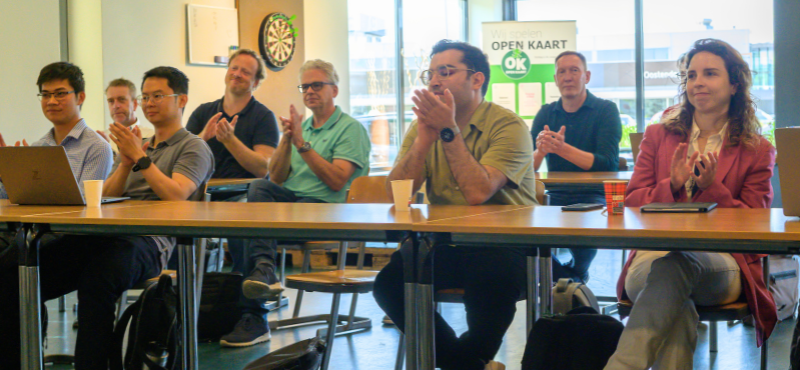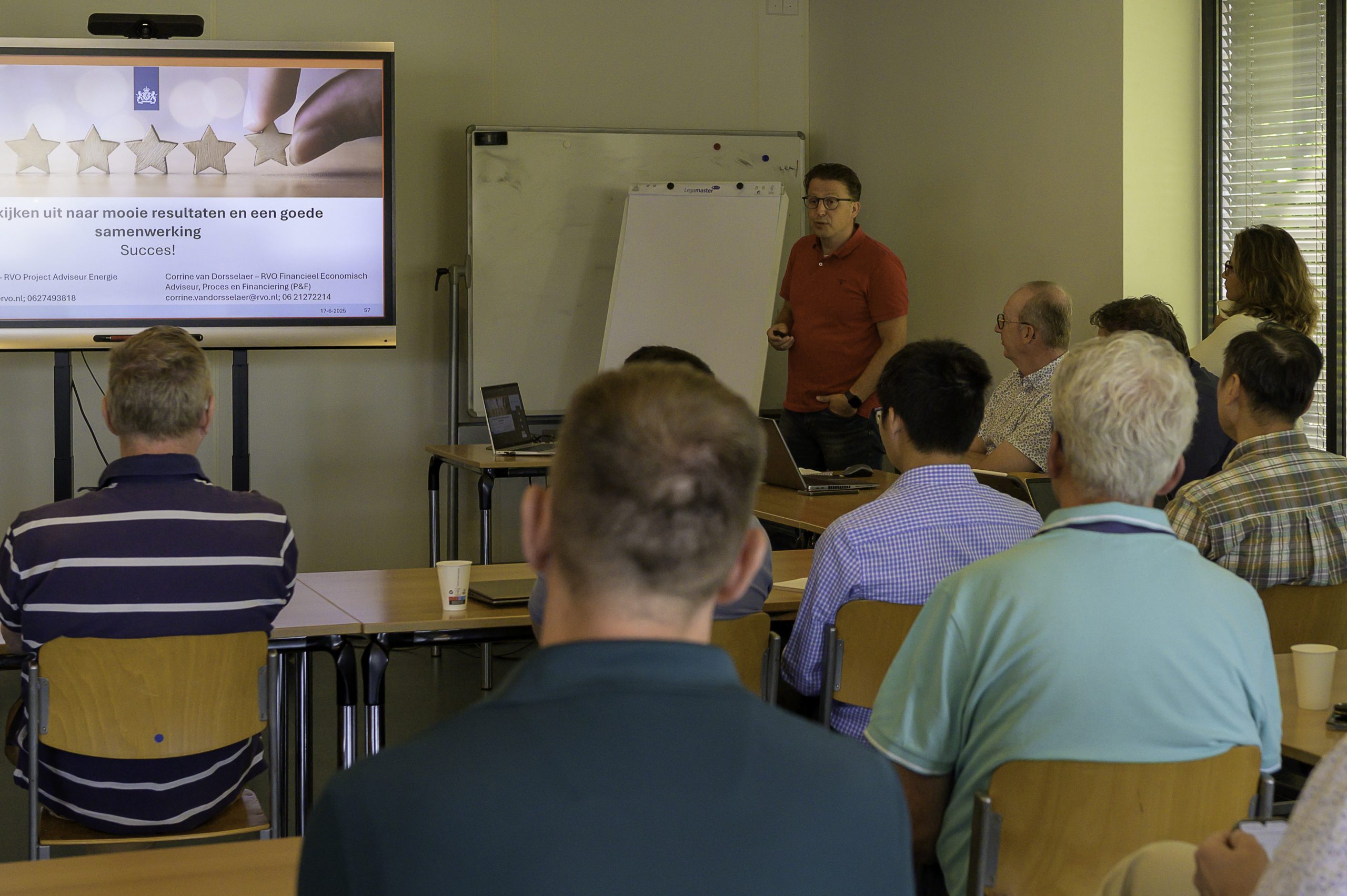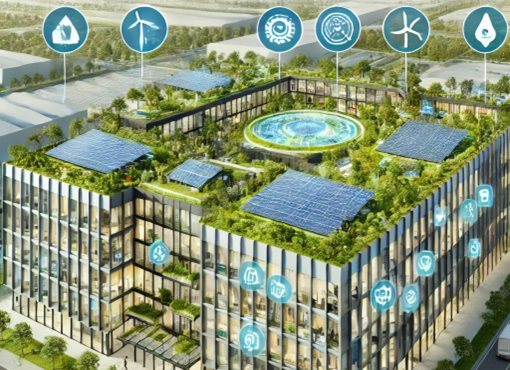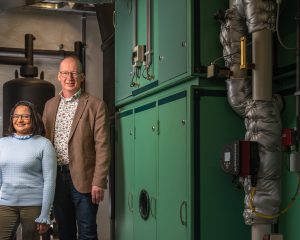
Advancing energy flexibility in buildings
Transforming building energy management with smart control systems
The BuildInFlexergy project, funded by the Dutch Mission-Driven Research, Development, and Innovation (MOOI) program, is revolutionizing building energy flexibility. This is supported by the Dutch Ministry of Economic Affairs and Climate Policy and the Ministry of the Interior and Kingdom Relations, and managed by the Netherlands Enterprise Agency (RVO). This four-year industry leading initiative unites 10 industry partners (including Eindhoven Engine) and 2 top universities (TU Eindhoven and TU Delft).
A unified approach to innovation
Coordinated and managed by Kropman B.V., the consortium includes installation companies, energy consultants, platform developers, building owners and managers, technology providers, and other experts. The aim is to foster open knowledge exchange and drive innovation through strategic collaboration and widespread dissemination of results.

Buildings at the heart of the energy transition
As the energy sector shifts towards a decentralized, digital, and low-carbon future, buildings—significant consumers of electricity and thermal energy—are key to providing demand-side flexibility. This flexibility allows buildings to adjust their energy use in response to external signals like electricity prices, carbon intensity, or grid constraints, without sacrificing occupant comfort or essential functions.
Kick-off meeting 17th June, 2025 | Kropman Nijmegen
The power of model predictive control
Model Predictive Control (MPC) is a cutting-edge tool for optimizing building energy performance. Unlike traditional control systems, MPC uses predictive models and real-time data to proactively manage a wide range of systems, including HVAC (Heating, Ventilation, and Air Conditioning), lighting, heat pumps, thermal storage, electric vehicles charging and other building loads It uses forecasts of occupancy, weather conditions and other relevant parameters to determine the best control actions over a future period, continuously updating the plan based on new data.
The aim of this project is to foster open knowledge exchange and drive innovation through strategic collaboration and widespread dissemination of results.

Real-time responsiveness with dynamic climate control
Dynamic climate control adjusts HVAC settings and ventilation rates based on changing indoor and outdoor conditions. This allows buildings to pre-cool or pre-heat spaces when renewable energy is plentiful or electricity prices are low, shifting loads without compromising comfort or overloading the grid.
Optimizing with key performance indicators
Key Performance Indicators (KPIs) are developed based on the Smart Readiness Indicator. KPIs guide decisions and balance objectives like energy cost, comfort, CO₂ emissions, and grid support. KPIs such as total energy consumption, peak load reduction, indoor comfort indices, and flexibility scores can be prioritized based on goals.
The future of building energy flexibility
The KPI-driven MPC framework makes buildings energy-efficient, grid-responsive, and climate-conscious. This approach is ideal for buildings in smart grids or demand response programs, supporting both building managers’ operational goals and energy system planners’ strategic targets.
In conclusion, combining MPC, dynamic climate control, and KPI-driven optimization can significantly enhance building energy flexibility. This strategy is crucial for making buildings active participants in the low-carbon energy system of the future.

Tackling energy challenges in buildings
The BuildInFlexergy approach
As buildings become increasingly reliant on electricity to maintain their indoor climate, they face challenges such as electricity supply and limited grid capacity.
To address these issues, Eindhoven Engine is happy to announce the BuildInFlexergy initiative commenced on May 1st, 2025.
Focus on energy flexibility
This project brings together 12 partners, including Eindhoven Engine. It aims to enhance the reliability and efficiency of local energy supply by better utilizing energy flexibility. Additionally, this initiative is particularly crucial for large, complex building systems equipped with heat pumps and thermal energy storage. These systems often experience stability and coordination issues, which can negatively impact both energy and comfort performance. Therefore, by focusing on energy flexibility, BuildInFlexergy aims to overcome these challenges and ensure a more stable and efficient energy supply for building.
Smart control systems and model predictive control
By transforming building energy management with smart control systems and model predictive control, we achieve real-time responsiveness and dynamic climate control. Moreover, this optimization uses key performance indicators. This unified approach to innovation places buildings at the heart of the energy transition, paving the way for the future of building energy flexibility.
This project not only addresses current challenges but also sets a precedent for future developments in energy-efficient building management.
The built environment is responsible for about 36% of the global energy demand. About 5-30% of the energy use of buildings is related to energy waste due to faults in heating, ventilation and air conditioning systems. The goal is to develop a self-learning module that can monitor and diagnose climate systems in large buildings.
Generic, robust and reliable fault detection & diagnosis tool
Rick Kramer is the leader of this project and Srinivasan is one of his PhD candidates. Srinivasan is focusing on developing a generic, robust and reliable fault detection and diagnosis tool that can help with the early detection of these faults and eliminate energy wastage.
Personalized control system in an office environment
Within this project, EngD trainee Petros is focusing on the people within large buildings. He is doing research on the control and functionality of a personalized control system that people will be able to use in their office environment to tailor it according to their needs and preferences.
Videos
The built environment is responsible for about 36% of the global energy demand. About 5-30% of the energy use of buildings is related to energy waste due to faults in heating, ventilation and air-conditioning systems. The goal is to develop a self-learning module that can monitor and diagnose climate systems in large buildings.
Rick Kramer – Project leader & Assistent Professor TU/e | Srinivasan Gopalan – PhD canditate TU/e
The goal is to develop a self-learning module that can monitor and diagnose climate systems in large buildings. Rick Kramer is the project leader of this project. Srinivasan is one of his PhD candidates who is focusing on developing a generic, robust and reliable fault detection and diagnosis tool
Petros Zimianitis – EngD trainee TU/e
Petros is focusing on the people within large buildings. He is doing research on the control and the functionality of a personalized control system, that people will be able to use in their office environment to tailor it according to their needs and preferences.

















